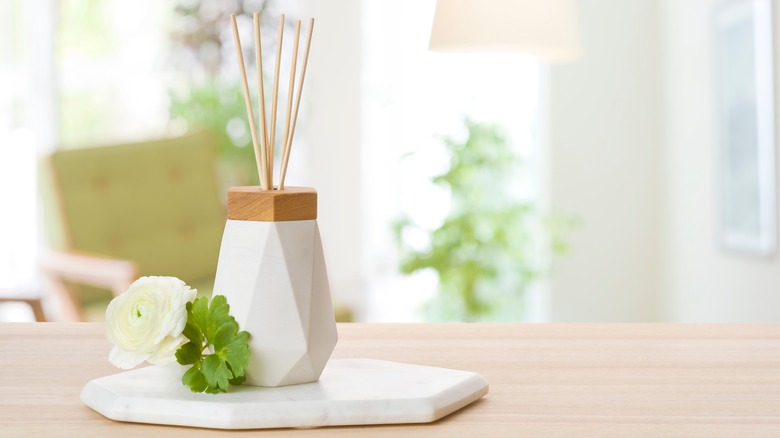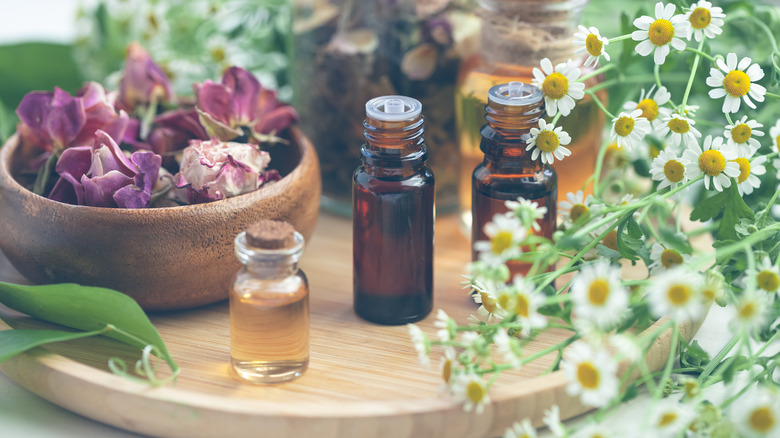DIY Your Own Reed Diffuser With Items You Likely Already Have At Home
We may receive a commission on purchases made from links.
When it comes to filling our spaces with soothing scents, there are several different products to try, but a reed diffuser is one of the most visually appealing and also one of the safest. They don't get plugged in, don't invite mold growth, are generally safe if kept out of reach of pets and children, and don't present a fire hazard. However, like all ambient aroma enhancers on the market, reed diffusers can get expensive. Luckily, you probably already have most of the materials required to DIY this seemingly luxe item yourself, making it a perfect fit for your household's needs. So grab a small bottleneck vase you're not using, grab those unused bamboo skewers and a neutral oil out of the kitchen, and dig through your pantry, medicine cabinet, or vanity for any pleasant extracts or essential oils you'd like to use.
There are, of course, certain essential oils that are toxic to your pets, but if you use 100% pure essential oils, keep them in a location where they're unlikely to be toppled over, and make sure your oil is properly diluted and in a well-ventilated area, it should be safe. You should never apply essential oils to your pet's skin or fur, and call the vet immediately if your pet has ingested essential oils or is exhibiting symptoms of gastrointestinal or respiratory distress.
DIY reed diffuser
An essential oil reed diffuser is a stylish addition to your home that guests will never guess was an easy DIY. You'll need a small vase with a wide base and a narrow top. The smaller the opening, the slower your scent will diffuse. Reeds can be purchased in home fragrance sections of stores, or if you like grilling, perhaps you have some extra bamboo skewers tucked away in the kitchen. If not, Walmart has a package of 100 for under $1. All that's left are the oils. You'll need a neutral carrier oil from your kitchen — such as avocado, coconut, or sunflower — and any pure essential oils you like for scent.
Determine how many reeds you'll use. It should fall somewhere between 6-12, depending on how big your vase is and what looks good to you. If you're using skewers, cut off the points using kitchen shears individually, or a cleaver and cutting board if you want to do them all at once to ensure similar lengths. Pour your neutral oil from a measuring cup into your vessel, about half of the way up, making note of how much you used. Add 25 drops of essential oil for every ¼ cup of neutral oil. If you are mixing scents, divide them to add up to 25 drops together. Soak the sticks in the oils for several minutes, then flip them over. Flip them again once a week to renew the scent.
Where to get essential oils
It's possible you already have food-grade essential oils in your kitchen. Used for flavorings, things like peppermint, citrus, anise, and even savory herbs come in essential oil form. If your bathroom is stocked with skin care, you might have essential oils like tea tree, lavender, and eucalyptus. You may even have an essential oil or two on hand for cleaning. Whatever essential oils you don't have, however, you can buy everywhere from craft stores to department stores, from discount stores like Walmart to online retailers like Amazon. Just make sure the packaging confirms they are 100% pure essential oils. This ensures they are derived only from the plant that produces the oil in question, not mixed with other oils or diluted with chemicals or other contaminants.
Of course, you do have the option to make your own essential oils, but the time and effort it takes to do this may far outweigh the benefits. The process requires a great deal of plant material, takes weeks to procure, and only produces a very small amount that won't be nearly as pure as store-bought options. It might be an interesting future project for your tween's science fair, though, so don't discount it entirely.


